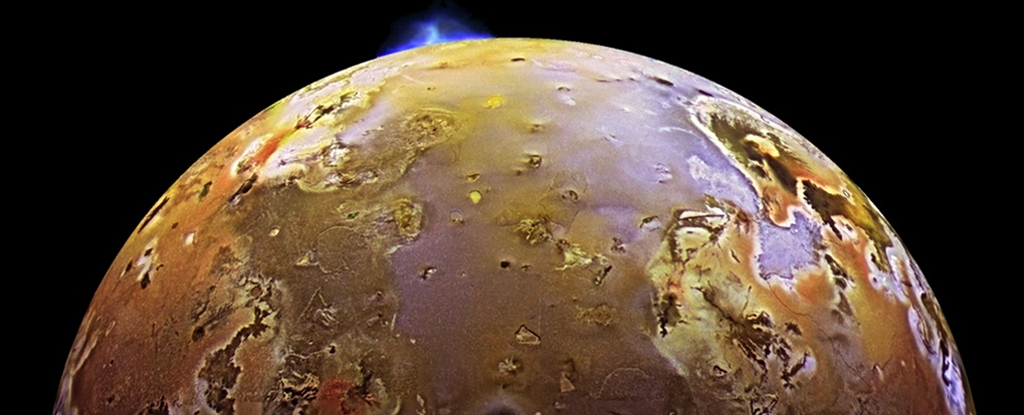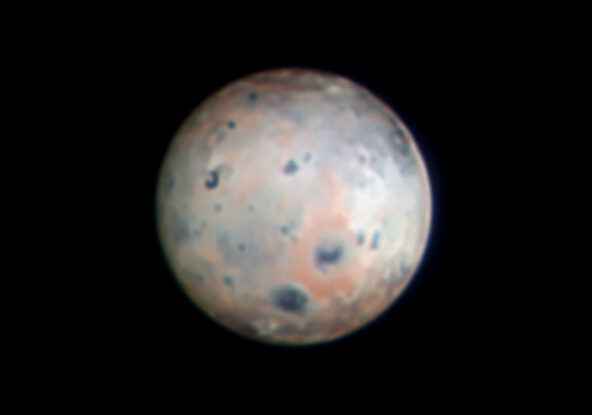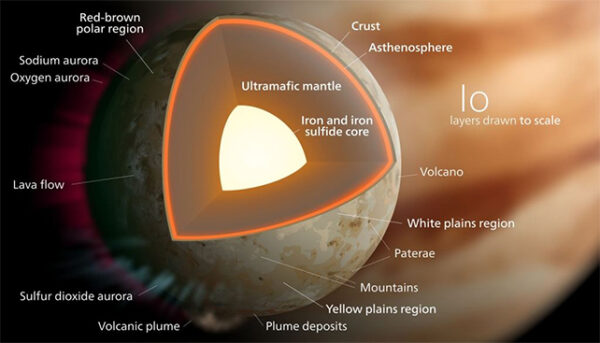
Posted on 06/06/2024 9:26:08 AM PDT by Red Badger

The Jovian moon Io as seen by the New Horizons spacecraft. The mission's camera caught a view of one of this moon's volcanos erupting. (NASA Goddard Space Flight Center Scientific Visualization Studio)
The Large Binocular Telescope (LBT), located on Mount Graham in Arizona and run by the University of Arizona, is part of the next generation of extremely large telescopes (ELTs). With two primary mirrors measuring 8.4 m (~27.5 ft), it has a collecting area slightly greater than that of a 30-meter (98.4 ft) telescope.
With their resolution, adaptive optics, and sophisticated instruments, these telescopes are expected to probe deeper into the Universe and provide stunning images of everything from distant galaxies to objects in our Solar System.
An international team led by the University of Arizona recently acquired images of Jupiter's moon Io that were the highest-resolution pictures ever taken by a ground-based telescope. The images revealed surface features measuring just 80 km (50 mi) across, a spatial resolution previously reserved for spacecraft.
This includes NASA's Juno mission, which has captured some of the most stunning images of Io's volcanoes. These images were made possible by the LBT's new SHARK-VIS instrument and the telescope's adaptive optics system.
The team was led by Al Conrad, an Associate Staff Scientist with the University of Arizona's Department of Astronomy, the Stewart Observatory, and the Large Binocular Telescope Observatory (LBTO). He was joined by researchers from the University of California, Berkeley, the California Institute of Technology, and NASA's Jet Propulsion Laboratory.
Their paper, "Observation of Io's Resurfacing via Plume Deposition Using Ground-Based Adaptive Optics at Visible Wavelengths With LBT SHARK-VIS (GRL)," and the LBT images are set to be published in the Geophysical Research Letters.
SHARK-VIS is a high-contrast optical coronagraphic imaging instrument designed and built at INAF-Osservatorio Astronomico di Roma. The instrument is fed by the refurbished LBT extreme Adaptive Optics system, called the Single conjugated adaptive Optics Upgrade for LBT (SOUL). It was installed in 2023 on the LBT along with the near-infrared instrument, SHARK-NIR, to take advantage of the telescope's outstanding adaptive optics system.
The key to the instrument is its fast, ultra-low-noise "fast imaging" camera that captures slow-motion footage that freezes the optical distortions caused by atmospheric interference.
Gianluca Li Causi, the data processing manager for SHARK-VIS at the Italian National Institute for Astrophysics, explained how it works in a recent University of Arizona News release:
"We process our data on the computer to remove any trace of the sensor's electronic footprint. We then select the best frames and combine them using a highly efficient software package called Kraken, developed by our colleagues Douglas Hope and Stuart Jefferies from Georgia State University. Kraken allows us to remove atmospheric effects, revealing Io in incredible sharpness."
The SHARK-VIS image was so rich in detail that it allowed the researchers to identify a major resurfacing event around Pele, one of Io's largest volcanoes located in the southern hemisphere near the equator (and named after the Hawaiin deity associated with fire and volcanoes).

Jupiter moon Io, imaged by SHARK-VIS on 10 January 2024. (INAF/Large Binocular Telescope Observatory/Georgia State University; IRV-band observations by SHARK-VIS/F. Pedichini; processing by D. Hope, S. Jefferies, G. Li Causi)
The image shows a plume deposit around Pele covered by eruption deposits from Pillan Patera, a neighboring volcano. NASA's Galileo spacecraft observed a similar eruption sequence while exploring the Jupiter system between 1995 and 2003. However, this was the first time an Earth-based observatory took such detailed images.
 An artist's concept of the interior of Io. (Kelvinsong/Wikimedia)
An artist's concept of the interior of Io. (Kelvinsong/Wikimedia)
"We interpret the changes as dark lava deposits and white sulfur dioxide deposits originating from an eruption at Pillan Patera, which partially cover Pele's red, sulfur-rich plume deposit," said co-author Ashley Davies, a principal scientist at NASA's Jet Propulsion Laboratory.
"Before SHARK-VIS, such resurfacing events were impossible to observe from Earth."
Io is the innermost of Jupiter's largest moons (aka. Galilean moons), which include Europa, Ganymede, and Callisto. Since NASA's Voyager 1 spacecraft flew through the Jupiter system in 1979, scientists have been fascinated by Io and its volcanic features.
Along with Europa and Ganymede, Io is locked in a 1:2:4 orbital resonance, where Europa makes two orbits for every orbit made by Ganymede, and Io makes four.
Between its interaction with these moons and Jupiter's powerful gravity, Io's interior is constantly flexing, producing hot lava that erupts through the surface. While telescopes have taken infrared images that revealed hot spots caused by eruptions, they are not sharp enough to reveal surface details or identify the locations of the eruptions. By monitoring the eruptions on Io's surface, scientists hope to gain insights into the tidal heating mechanism responsible for Io's intense volcanism.
"Io, therefore, presents a unique opportunity to learn about the mighty eruptions that helped shape the surfaces of the Earth and the moon in their distant pasts," said Conrad.
Studies like this one, he added, will help researchers understand why some planets have active volcanoes while others do not. For instance, while Venus is thought to still be volcanically active, Mars is home to the largest volcanoes in the Solar System but is inactive.
These studies may also shed light on volcanic exoplanets someday, helping astronomers to identify geological activity on distant planets (a possible indication of habitability).
SHARK-VIS instrument scientist Simone Antoniucci anticipates that it will enable new observations of objects throughout the Solar System with similar sharpness, revealing all manner of features that would otherwise require spacecraft.
"The keen vision of SHARK-VIS is particularly suited to observing the surfaces of many solar system bodies, not only the moons of giant planets but also asteroids," he said.
"We have already observed some of those, with the data currently being analyzed, and are planning to observe more."
This article was originally published by Universe Today. Read the original article.
I-O, I-O, It’s off to work I go!..............

Magma is both liquid and hot.
If it’s not, it’s a rock................
That truly IS an incredible picture, considering it was taken from Earth. It is stunning….
Makes me laugh every single time!
Is this one of those moons with oceans of liquid hydrocarbons, you know, from dead inter-planetary plankton and dinosaurs?
No, that would be Europa..........
Hydrocarbons?...That would be Titan................
When I saw the first image, I thought “impossible”. Then I read the article.
The first pic is from New Horizons spacecraft as it flew by Jupiter on its way to Pluto. The second pic is from a ground based telescope. Still amazing from a ground based telescope.
As long as it is not Europa.
“ALL THESE WORLDS ARE YOURS, EXCEPT EUROPA.ATTEMPT NO LANDING THERE.”
‘With two primary mirrors measuring 8.4 m (~27.5 ft), it has a collecting area slightly greater than that of a 30-meter (98.4 ft) telescope.“
No it doesn’t.
Maybe it has the effective aperture (and thus resolving power) of a 30 meter telescope in one axis (direction of separation of the two individual telescopes) but not the effective area (and thus light gathering power).
Not slighting the optics accomplishment, which is amazing, but the writer didn’t even understand what the accomplishment is.
The reason was revealed in a sequel.
There’s a small, intelligent lifeform evolving on Europa that needs protection.......................
Disclaimer: Opinions posted on Free Republic are those of the individual posters and do not necessarily represent the opinion of Free Republic or its management. All materials posted herein are protected by copyright law and the exemption for fair use of copyrighted works.